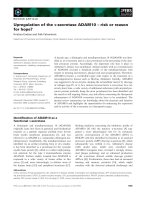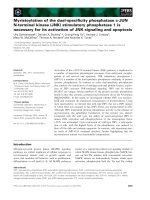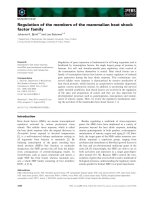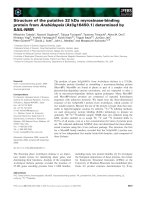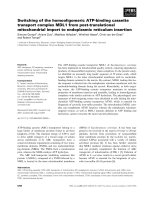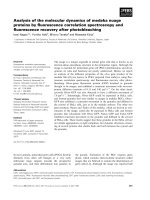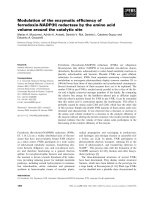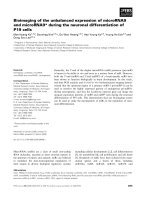Báo cáo khoa học: Binding of the viral immunogenic octapeptide VSV8 to native glucose-regulated protein Grp94 (gp96) and its inhibition by the physiological ligands ATP and Ca2+ Ming Ying and Torgeir Flatmark pot
Bạn đang xem bản rút gọn của tài liệu. Xem và tải ngay bản đầy đủ của tài liệu tại đây (193.34 KB, 10 trang )
Binding of the viral immunogenic octapeptide VSV8 to
native glucose-regulated protein Grp94 (gp96) and its
inhibition by the physiological ligands ATP and Ca
2+
Ming Ying and Torgeir Flatmark
Section of Biochemistry and Molecular Biology, Department of Biomedicine, University of Bergen, Norway
Grp94 (gp96), a major chaperone of the ER lumen
and a paralogue of the cytoplasmic chaperone Hsp90,
plays an essential role in the structural maturation
and ⁄ or secretion of a subset of client (cargo) proteins
destined for transport to the cell surface [1]. Related
studies have indicated that Grp94 also associates with
a wide array of immunogenic peptides generated in the
cytosol or in the early secretory pathway. Such Grp–
peptide complexes have been proposed to interact with
antigen-presenting cells (APC) in a specific manner
that eventually leads to the presentation of peptides by
the major histocompatability complex (MHC) class I
molecules of the APCs [2]. The immunodominant viral
octapeptide RGYVYQGL (VSV8), derived from vesicu-
lar stomatitis virus nucleoprotein (residues 52–59), has
been identified as a MHC class I H2-Kb ⁄ H2-Kd epi-
tope ( />epimhc/) and a Grp94 ligand in VSV-infected cells [3],
and has been shown to bind to Grp94 in vitro [4–7].
The generally reported low affinity and low stoichio-
metry of peptide binding to Grp94 in vitro, and the
finding that this binding seems to be almost irrevers-
ible, have questioned the proposed in vivo peptide
acceptor–donor function of the chaperone [8,9]. Thus,
in previous in vitro studies peptide binding to Grp94
was artificially enhanced by experimental conditions
that elicit a more open conformational state of the
chaperone, i.e. by heat shock denaturation (50–60 °C)
[5–7,10], by a chemically induced conformational
change [6] or by high salt concentrations [5]. More-
over, the binding assays were based on incubations of
Grp94 and radiolabelled ligand for 1–20 h [7]. Finally,
no physiological ligands favouring such conformation-
al states of Grp94 have been defined, and a better
understanding of the interaction of the native chaper-
one with ‘client’ peptides and the possible regulation
Keywords
ATP; cations; Grp94; SPR; VSV8
Correspondence
T. Flatmark, Section of Biochemistry and
Molecular Biology, Department of
Biomedicine, University of Bergen, Jonas
Lies vei 91, N-5009 Bergen, Norway
Fax: +47 55 586360
Tel: +47 55 586428
E-mail: torgeir.fl
(Received 30 September 2005, revised
1 December 2005, accepted 2 December
2005)
doi:10.1111/j.1742-4658.2005.05084.x
The molecular chaperone Grp94 (gp96) of the endoplasmic reticulum (ER)
lumen plays an essential role in the structural maturation and ⁄ or secretion of
proteins destined for transport to the cell surface. Its proposed role in binding
and transferring peptides for immune recognition is, however, controversial.
Using SPR spectroscopy, we studied the interaction of native glycosylated
Grp94 at neutral pH and 25 and 37 °C with the viral immunogenic octa-
peptide RGYVYQGL (VSV8), derived from vesicular stomatitis virus
nucleoprotein (52–59). The peptide binds reversibly with low affinity
([A]
0.5
640 lm) and a hyperbolic binding isotherm, and the binding is par-
tially inhibited by ATP and Ca
2+
at concentrations that are present in the
ER lumen, and the effects are explained by conformational changes in the
native chaperone induced by these ligands. Our data present experimental
support for the recent proposal that, under native conditions, VSV8 binds
to Grp94 by an adsorptive, rather than a bioselective, mechanism, and thus
further challenge the proposed in vivo peptide acceptor–donor function
of the chaperone in the context of antigen-presenting cell activation.
Abbreviations
APC, antigen-presenting cell; dn ⁄ dc, refractive index increment; ERGIC, ER ⁄ Golgi intermediate compartment; Grp78 (BiP), ER glucose-
regulated protein of 78 kDa; Grp94 (gp96), ER glucose-regulated protein of 94 kDa; MHC, major histocompatability complex; NECA,
5¢-N-ethylcarboxamidoadenosine; RU, resonance unit; TAP, transporter associated with antigen presentation.
FEBS Journal 273 (2006) 513–522 ª 2006 The Authors Journal compilation ª 2006 FEBS 513
of this function by ligand interactions is considered
imperative [9]. In this study, SPR spectroscopy was
used to study multiple ligand-binding events in real
time to the immobilized native glycosylated Grp94
(rGrp94) and nonglycosylated recombinant Grp94 at
25 or 37 °C. Special attention was paid to the reversi-
ble binding of the viral immunogenic octpeptide RGY-
VYQGL (VSV8) and physiological low-molecular mass
ligands of the ER lumenal compartment (Ca
2+
and
ATP), known to regulate the function of Grp94 as a
protein chaperone [4,11,12]. Thus, the SPR binding
studies provide new insights into native Grp94–ligand
interactions related to its proposed in vivo peptide
binding and antigen presentation activity.
Results
Previous in vitro studies on the peptide-binding activity
of Grp94 [6,7] have not given any equilibrium-binding
parameters for peptide binding to the native chaperone
or identified any physiological factors in the ER
lumenal environment which may have a regulatory
effect on the Grp94–peptide interactions. In this study
we addressed both questions by choosing SPR as the
experimental approach to study the interactions
ofGrp94 in real time with the viral immunogenic
octapeptide VSV8 and some known physiological low-
molecular mass ligands of the chaperone in the ER
lumenal compartment which may perturb this inter-
action.
Binding of the viral immunogenic octapeptide
VSV8 to native rGrp94
Native glycosylated rat Grp94 (rGrp94) and recombin-
ant nonglycosylated Grp94 were immobilized using
carbodiimide-activated amine coupling so that the chip
surface might present random orientations of Grp94
molecules. Figure 1A shows a series of sensorgrams
for the binding of VSV8 to rGrp94 at 25 °C and
pH 7.4, corrected for the change in refractive index
observed on the adjacent mock-immobilized surface of
the same chip. The kinetics of both association and
dissociation are near the limit of being too fast to be
analysed quantitatively with confidence. Thus, the
response values at the steady-state plateau were taken
as a measure of the amount of ligand bound to the
sensor surface. The sensorgrams show increasing
response to concentrations of VSV8 in the range
10 lm to 1 mm, and from the hyperbolic equilibrium
binding isotherm (Fig. 1B) a [A]
0.5
of 640 lm and a
global R
max
(obs) of 27 RUÆ(ng proteinÆmm
)2
) was
estimated. The binding affinity was decreased at 37 °C,
Fig. 1. Binding of VSV8 to immobilized native glycosylated rGrp94
as measured by SPR. rGrp94 was immobilized on the sensor chip
at 15 856 RU, and the binding of VSV8 was studied at 25 °C and
pH 7.4 in HBS-P buffer. (A) Representative sensorgrams at 0, 100,
500 and 1000 l
M VSV8. (B) The equilibrium-binding isotherm with a
half-maximal response ([A]
0.5
)at 640 lM of VSV8 and a global
R
max
(obs) of 27 RUÆ(ng proteinÆmm
)2
). (C) D ouble-reciprocal plot of
the equilibrium-binding isotherms obtained in the absence of
ATP ⁄ Ca
2+
(d), in the presence of 500 lM ATP (.) and in the pres-
ence of 500 l
M Ca
2+
(s) in the flow buffer.
Grp94–ligand interactions M. Ying and T. Flatmark
514 FEBS Journal 273 (2006) 513–522 ª 2006 The Authors Journal compilation ª 2006 FEBS
but slightly increased by lowering the pH from 7.4 to
6.5 [approximate pH of the ER ⁄ Golgi intermediate
(ERGIC) compartment] [13] (not shown). Essentially
identical results and binding parameters were obtained
for recombinant nonglycosylated Grp94 (not shown).
Moreover, the low-molecular mass analytes ATP and
Ca
2+
at concentrations near the physiological levels in
the ER were both found to inhibit rGrp94 binding of
VSV8 (Fig. 1C), most pronounced for ATP at low
concentrations of the peptide (see below). However, at
this ATP concentration we observed no significant
effect on the binding of VSV8 to the recombinant ER
chaperone Grp78 ⁄ BiP (not shown).
Although SPR typically offers no direct information
about stoichiometry, an estimate was obtained from
Eqn 2 (Experimental Procedures) by assuming a single
binding site (n ¼ 1) per rGrp94 monomer (96 kDa) for
VSV8 and the same refractive index increment [dn ⁄ dc
(cm
3
Æg
)1
)] as for the immobilized protein [14]. Thus, an
R
max
(theoretical) of 4.9 RUÆ(ng proteinÆmm
-2
) was cal-
culated for the rGrp94 monomer, which represents
18% of the R
max
(obs) of 27 RUÆ(ng proteinÆmm
-2
)as
calculated from the binding isotherm (Fig. 1B). VSV8
is a water soluble peptide and is shown structurally to
be in an extended and flexible monomeric state [15],
and it was most likely a monomer at the experimental
conditions used. This indicates that rGrp94 contains
multiple low-affinity binding sites for VSV8.
Binding of ATP, MgATP and NECA to rGrp94
The function of Grp94 as a protein chaperone is repor-
ted to be sensitive to ER lumenal ATP levels [11]. The
chaperone has been reported to bind ATP and ADP
with estimated K
d
-values in the millimolar concentration
range [16], and the recently obtained three-dimensional
structure of its N-terminal domain in complex with ATP
and ADP has revealed a nucleotide-induced conforma-
tional switch in the chaperone [17]. SPR analyses of the
full-length glycosylated protein are in agreement with
both observations. ATP binds to the full-length rGrp94
and the binding results in a negative SPR signal
(Fig. 2A). This unusual response can only be explained
by a ligand-induced conformational change, because a
positive signal was expected due to the increased surface
mass contribution of bound ATP (507 Da) as observed
in a control experiment with the ER chaperone
Grp78 ⁄ BiP (Fig. 2C). From the negative response iso-
therm obtained within the concentration range of
0–500 lm ATP an apparent [A]
0.5
of 90 lm was esti-
mated (Fig. 2B). Owing to the mixed contribution of ATP
binding to the overall SPR signal response, i.e. a positive
DRU due to an increased surface mass concentration,
Fig. 2. Binding of ATP to immobilized native glycosylated rGrp94
and recombinant Grp78 ⁄ BiP as measured by SPR. rGrp94 and
Grp78 ⁄ BiP were immobilized on the sensor chip at 15 945 and
2323 RU, respectively, and the binding of ATP was studied at
25 °C and pH 7.4 in HBS-P buffer. (A) Representative sensorgrams
for rGrp94 at 10, 75, 150 and 300 l
M of ATP. (B) The equilibrium-
response isotherm for rGrp94 within the range 0–500 l
M ATP with
a half-maximal response ([A]
0.5
)at 90 lM ATP. (C) The equilib-
rium-response isotherm for Grp78 ⁄ BiP with a half-maximal
response ([A]
0.5
)at 170 lM ATP.
M. Ying and T. Flatmark Grp94–ligand interactions
FEBS Journal 273 (2006) 513–522 ª 2006 The Authors Journal compilation ª 2006 FEBS 515
and a negative DRU due to the ligand-induced conform-
ational change, no exact value for the binding affinity
and the stoichiometry of ATP binding could be deter-
mined. By contrast, in the same concentration range
MgATP (at a molar ratio of Mg
2+
: ATP ¼ 2 : 1) gave
a positive SPR signal with an apparent [A]
0.5
of 5.8 mm
(Fig. 4B). Almost the same response isotherm was
obtained for nonglycosylated recombinant Grp94 (not
shown), and from Fig. 2C it is seen that in a control
experiment with Grp78 ⁄ BiP ATP binds with a posit-
ive SPR response isotherm, and [A]
0.5
was 170 lm.
DRU
max
[1.75 RUÆ(ng proteinÆmm
)2
)] calculated from
the response isotherm by nonlinear regression analysis is
similar to the R
max
(theoretical) ¼ 1.63 calculated from
Eqn 2 using the estimated dn ⁄ dc value for ATP (i.e.
63% of that for VSV8), indicating an apparent 1 : 1
stoichiometry of ATP binding to Grp78 ⁄ BiP monomer
(78 kDa).
Grp94 was found to bind the substituted adenosine
analogue 5¢-(N-ethylcarboxamido) adenosine (NECA)
with submicromolar affinity [16]. The crystal structure
of a monomeric double-truncated form of canine
Grp94 (residues 69–337D40) has more recently revealed
that NECA binds to a conserved adenine-binding cav-
ity and a second partially hydrophobic pocket, and the
presence of an adenosine nucleotide-induced conforma-
tional switch was predicted [18] and recently confirmed
[17]. Our SPR analyses (Fig. 3) also support the con-
clusion that NECA (308 Da) binds to native rGrp94
with high affinity, relative to ATP. In contrast to ATP
the SPR response to NECA was positive, and the
equilibrium binding isotherm was hyperbolic with a
well-defined saturating SPR response and an apparent
[A]
0.5
of 550 nm.
Binding of divalent cations to rGrp94
The function of Grp94 as a protein chaperone is also
sensitive to ER lumenal calcium levels [12,19]. Like the
other abundant lumenal proteins of the ER, Grp94 is
a low-affinity, high-capacity calcium-binding protein,
making it one of the important calcium-storage and
-buffer proteins of the ER [20]. Our SPR binding stud-
ies (Fig. 4A) revealed that Ca
2+
(40 Da) binds to
rGrp94 at pH 7.4 with a positive SPR signal and the
Fig. 3. Binding of NECA to immobilized native glycosylated rGrp94
as measured by SPR. rGrp94 was immobilized on the sensor chip
at 16 239 RU, and the binding of NECA was measured within the
concentration range of 0–90 l
M at 25 °C and pH 7.4 in HBS-P buf-
fer containing 1% (v ⁄ v) dimethylsulfoxide. The hyperbolic equilib-
rium binding isotherm revealed a well-defined saturating SPR
response with a half-maximal response ([A]
0.5
)at 550 nM.
Fig. 4. Binding of divalent cations to immobilized native glycosylat-
ed rGrp94 as measured by SPR. rGrp94 was immobilized on the
sensor chip at 18 230 RU, and the binding was studied at 25 °C
and pH 7.4 in HBS-P buffer. (A) Representative sensorgrams
obtained at 100, 400, 1000 and 3000 l
M Ca
2+
. (B) The equilibrium-
binding isotherms for Ca
2+
(d), Mg
2+
(s), MgATP (.) and Na
+
(n)
with a half-maximal response ([A]
0.5
) at 2.8 mM for Ca
2+
and
9.6 m
M for Mg
2+
.
Grp94–ligand interactions M. Ying and T. Flatmark
516 FEBS Journal 273 (2006) 513–522 ª 2006 The Authors Journal compilation ª 2006 FEBS
‘square-wave’ sensorgram is typical for a low-affinity
binding analyte [21,22]. From the slightly sigmoidal
equilibrium response isotherm (n
H
¼ 1.2) an apparent
[A]
0.5
of 2.8 mm and an R
max
of 39 RUÆ(ng pro-
teinÆmm
)2
) was estimated by nonlinear regression ana-
lysis (Fig. 4B). By contrast, at pH 6.5 a hyperbolic
response isotherm (n
H
¼ 1.0) was obtained with an
apparent [A]
0.5
of 8.6 mm, demonstrating a reduced
affinity and noncooperative binding at this acidic pH
(not shown). From Fig. 4B it is seen that rGrp94 also
binds Mg
2+
(24 Da) at pH 7.4 in the same concentra-
tion range as Ca
2+
, but with a lower apparent affinity
([A]
0.5
¼ 9.6 mm), indicating that at least some of the
cation-binding sites are of a mixed Ca
2+
⁄ Mg
2+
type.
By contrast, Na
+
(NaCl) gave only a very small SPR
response indicating very little contribution of an ionic
strength effect to the responses observed for Ca
2+
(CaCl
2
) and Mg
2+
(MgCl
2
). Interestingly, the SPR
response to Mg
2+
was higher than for MgATP at equal
concentrations (Fig. 4B) which may be explained by
the negative SPR signal resulting from the binding
of ATP alone (Fig. 2). By assuming the same
dn ⁄ dc (cm
3
Æg
)1
) for Ca
2+
as for rGrp94 (which is likely
an overestimation), an approximate theoretical R
max
-
value due to the contribution of the surface concentra-
tion (ngÆmm
)2
) of the analyte alone was estimated from
Eqn 2 to R
max
(theoretical) ¼ 43 RU at 17 000 RU
immobilized, i.e. 2.5 RUÆ(ng proteinÆmm
)2
), for the
n ¼ 15 binding sites previously estimated [20]. From
the response isotherm (Fig. 4B) a R
max
of 39 RUÆ
(ng proteinÆmm
)2
) was obtained by nonlinear regres-
sion analysis indicating that the SPR response to Ca
2+
largely may reflect a concentration dependent global
conformational change of the protein in addition to the
increased surface mass concentration.
Interaction between Grp94 and other molecular
chaperones of the ER
Several ER resident proteins are calcium-binding with
low affinity and high capacity [20], and they have been
proposed to weakly interact through a ‘calcium matrix’
[19]. In order to test whether Grp94 interacts with two
of these proteins, the molecular chaperones Grp78 ⁄ BiP
and calreticulin, rGrp94 and recombinant Grp78 ⁄ BiP
were immobilized on CM5 sensor chips by the stand-
ard procedure at a surface concentration of 3.4–5.6 ng
proteinÆmm
)2
, respectively. In the experiments with
immobilized rGrp94 the injection of the recombinant
forms of Grp78 ⁄ BiP and calreticulin, dissolved at vari-
able concentrations in the flow buffer (HBS-P at
pH 7.4 or 6.5), revealed no binding in the absence
or presence of up to 3 mm Ca
2+
or 500 lm ATP (not
shown). Similar negative binding results were obtained
when Grp78 ⁄ BiP was immobilized on the sensor chip
and rGrp94 was injected over the surface (not shown).
Discussion
The ER provides a tightly regulated environment for
the folding and maturation of proteins destined to enter
the secretory pathway [23], and the most abundant
resident proteins (Grp94, Grp78 ⁄ BiP, protein disulfide
isomerase and calreticulin) all function in protein fold-
ing. A characteristic feature of these molecular chaper-
ones is the wide diversity of ligand-binding properties,
including specificity and affinity [23]. In this study
we addressed the proposal that Grp94 also has a
peptide acceptor–donor function related to antigen pres-
entation [2], using SPR spectroscopy as a biophysical
method to study in vitro its multiple binding properties.
ATP- and Ca
2+
-induced conformational changes
of native rGrp94
Although there is general agreement that Grp94 binds
ATP and has a low ATPase activity, their functional
significance has been controversial [4,16,17,24]. In this
study, ATP was found to bind to native glycosylated
and nonglycosylated recombinant Grp94 with relat-
ively low apparent affinity, and with a complex SPR
response isotherm. In contrast to the titration of the
ER chaperone Grp78 ⁄ BiP with ATP (Fig. 2C), the
SPR signal obtained with Grp94 was net negative at
all concentrations of the nucleotide (Fig. 2B), showing
that the response is dominated by an ATP-induced
conformational change. This conclusion is in agree-
ment with the change in conformation observed as a
loss of an epitope-specific antibody binding in the pres-
ence of ATP [7] and more recently crystallographically
as a large conformational change in the N-terminal
nucleotide binding domain of a C-terminal truncated
form of Grp94 upon ATP binding [17]. These struc-
tural studies also revealed a different binding mode for
the adenosine analog NECA which in this study binds
to rGrp94 with relatively high affinity and with a net
positive SPR response. Interestingly, a similar negative
conformation-dependent SPR response as observed for
ATP binding to rGrp94 has been reported for the
binding of maltose to the maltose-binding protein of
Escherichia coli [25]. In that case it was shown crystal-
lographically that the ligand binding induced a con-
formational change which caused a net decrease in the
hydrodynamic radius of the protein [26], and the
observed negative SPR response was considered to be
a function of the net change in hydrodynamic radius
M. Ying and T. Flatmark Grp94–ligand interactions
FEBS Journal 273 (2006) 513–522 ª 2006 The Authors Journal compilation ª 2006 FEBS 517
that occurs upon maltose binding [25]. By contrast, in
our control experiment with Grp78 ⁄ BiP ATP was
found to bind with a positive SPR signal (Fig. 2C),
and the response isotherm gave a [A]
0.5
of 168 lm.
Although Grp78 ⁄ BiP and Grp94 are the two major
recipients of the pool of ATP translocated into the
lumen of ER [24] the effects of ATP binding are quite
different for the two chaperones. Thus, Grp78 ⁄ BiP has
a weak ATPase activity which is stimulated by its
binding of exogenous polypeptides [27] and is further
regulated by ER cochaperones [28]. Grp94, by con-
trast, has an unusually weak ATPase activity [4,16]
which is inhibited or not stimulated by exogenous pep-
tides [4], and the precise role of ATP binding ⁄ hydro-
lysis in the in vivo chaperoning function of Grp94
remains unclear [1,29].
Four ER lumenal calcium-binding glycoproteins were
originally reported in isolated rat liver microsomes [20].
A major component was Grp94, suggesting that one of
its roles might be in the calcium-storage and -buffer
function of the ER. Moreover, calcium has been shown
to be required for the retention of Grp94 in the ER [12],
as well as to be involved in the transport of secretory
proteins out of the ER [19], and Grp94 may thus also be
considered as a Ca
2+
sensor protein. In this study, it is
confirmed that native rGrp94 possess multiple low-affin-
ity binding sites for Ca
2+
[20]. As reported above (see
Results) the theoretical maximum SPR signal [R
max
(the-
oretical) ¼ 2.5 RUÆ(ng proteinÆmm
)2
)] assuming 15
binding sites for Ca
2+
[20] was markedly lower than the
observed SPR value [R
max
¼ 39 RUÆ(ng proteinÆ
mm
)2
)], indicating a major contribution of a Ca
2+
-
induced conformational transition to the overall SPR
response. This finding is in agreement with a previous
far-UV CD spectroscopic study that calcium causes a
conformational change in Grp94 with a decrease in the
a-helical content from 40 to 34% [20]. Interestingly, the
large conformation-dependent enhancement of the SPR
response observed in our study is similar to that previ-
ously observed for Ca
2+
binding to tissue transglutami-
nase [25], an allosteric enzyme which undergo significant
conformational changes, including an increase in its
hydrodynamic radius, upon binding of Ca
2+
[30].
Peptide-binding properties of native rGrp94 and
its inhibition by physiological ER ligands
Since the original studies by Srivastava et al. [31] it
has been considered that Grp94 has the ability to bind
a subset of immunogenic peptides and is actively
involved in loading transporter associated with antigen
presentation (TAP)-translocated peptides onto MHC
class I molecules [2]. However, a direct role of Grp94
in antigen presentation is highly controversial and has
still to be formally proven [8,9]. In particular, the
reported low affinity and low stoichiometry of peptide
binding to Grp94 in vitro, and the finding that the pep-
tide binding seems to be almost irreversible at the
selected experimental in vitro conditions (usually invol-
ving heat shock denaturation and aggregation of the
chaperone), are observations which have questioned its
proposed peptide acceptor–donor function in vivo [8].
In this study, a low affinity was observed for the fully
reversible binding of VSV8 to native glycosylated and
nonglycosylated recombinant Grp94 (pH 7.4 or 6.5
and 25 or 37 °C), with a hyperbolic equilibrium bind-
ing isotherm and half-maximal binding at 640 lm
(pH 7.4 and 25 °C). A similar low affinity was
observed for the binding of VSV8 to Grp78 ⁄ BiP, i.e.
[A]
0.5
560 lm (not shown), in agreement with the
previously published low-affinity binding of a library
of 7-mer peptides to this chaperone [27]. Moreover, at
saturation (extrapolated value) an apparent maximal
stoichiometry 6 mol peptide per mol of rGrp94
monomer was estimated (see Results) which presents
experimental support for the recent hypothetical pro-
posal [9] of a binding of peptides to this chaperone by
an adsorptive, rather than a bioselective, mechanism.
A further argument [9] against the function of Grp94
in binding and transferring peptides for antigen presen-
tation has been that peptide binding in vitro is consid-
ered to be very stable, almost irreversible [5,7,8,10].
Thus, previous in vitro studies on Grp94 binding of
radiolabelled synthetic peptides were performed under
nonequilibrium binding conditions using a chaperone
exposed to either heat shock denaturation and aggre-
gation (50–60 °C) or to a chemically induced conform-
ational change in connection with long incubation
times (1–20 h) [5–7,10]. In this study, the SPR analyses
revealed an equilibrium binding of VSV8 to native
rGrp94 at pH 7.4 and 25 or 37 °C which was com-
pletely reversible. Moreover, the rate of dissociation
was very rapid (t
½
¼ 7.2 ± 1.2 s; n ¼ 10) and incom-
patible with the proposed peptide acceptor–donor
function of the chaperone [31]. Thus, the VSV8-bind-
ing sites ⁄ interactions in native Grp94 (this study)
appear to be different from that observed for non-
native forms of the protein [7,10]. A further argument
is our finding that the binding of VSV8 was partly
inhibited by ATP at concentrations (500 lm) consid-
ered to be physiological in the ER and ERGIC lume-
nal compartments [24], and most pronounced at the
low concentrations of VSV8. The inhibitory effect of
ATP is most likely related to the ATP-induced con-
formational change discussed above, and a certain con-
formation-related inhibition was also observed at the
Grp94–ligand interactions M. Ying and T. Flatmark
518 FEBS Journal 273 (2006) 513–522 ª 2006 The Authors Journal compilation ª 2006 FEBS
reported high (mm) total concentration of Ca
2+
in the
ER lumen [32]. This may explain a previous observa-
tion that Grp94 and six other ER proteins were selec-
tively bound to an affinity column of denatured
histone and specifically eluted by ATP, and that the
release of Grp94 was further stimulated by
Ca
2+
⁄ Mg
2+
[33].
Additional, as yet unidentified, cofactors present in
the lumenal ER compartment in vivo may also affect
the peptide-binding properties of native Grp94, inclu-
ding its binding parameters. However, interactions of
Grp94 with its two related ER lumenal chaperones
Grp78 ⁄ BiP and calreticulin were excluded from this
study. By analogy to Grp78 ⁄ BiP [28] and the cytoplas-
mic Hsp90, it is possible that the function of Grp94
may be regulated by physical interactions with cochap-
erones, but to date there is no direct evidence for the
existence of ER homologues of Hsp90-associated pro-
teins [1]. Moreover, it should be noted that a low affin-
ity of peptide binding to native Grp94 has been
observed also in experiments at the cellular level. Thus,
Lammert et al. [34], in their studies on streptolysine-
permeabilized cells, found that radiolabelled peptides
are translocated into the ER lumen by the TAP trans-
porter and thus bind to Grp94. The fact that the
affinity-purified Grp94 could only be labelled with
TAP-translocated peptides containing a photo-cross-
linker (a photoreactive phenylalanine label) was inter-
preted as reflecting a weak interaction of the peptides
with the chaperone. Finally, recent quantitative and
structural analyses of peptides extracted from a
Grp94-enriched glycoprotein fraction, isolated by con-
cavalin A affinity chromatography from a T-cell lym-
phoma tumour cell line, revealed a peptide occupancy
of only 0.1–0.4% compared with 100% occupancy
for MHC class I molecules [35]. The specific nature of
Grp94-associated peptides, compared with those pre-
sented by MHC class I molecules, together with the
far substoichiometric occupancy of Grp94, strongly
suggested that Grp94 is not a peptide chaperone
involved in antigen processing [35].
Concluding remarks
Our data present experimental support for the recent
proposal by Nicchitta et al. [9] that VSV8 under native
conditions binds to Grp94 by an adsorptive, rather
than a bioselective, mechanism, and thus further chal-
lenge the proposed in vivo peptide acceptor–donor
function of the chaperone in the context of APC acti-
vation [2,31]. Moreover, Nicchitta et al. [8,9] also pro-
posed an alternative mechanism, in which Grp94 may
function by inducing an activation of the immune
system independent of bound peptides. Such a mech-
anism is supported by a recent study [36] demonstra-
ting that Grp94 and its N-terminal fragment induce an
enhancement of the humoral immune responses to a
protein antigen (HbsAg), related to the chaperone as
an adjuvant.
Experimental procedures
The octapeptide VSV8 (RGYVYQGL), derived from VSV
nucleoprotein (residues 52–59), was synthesized by Euro-
gentec (Seraing, Belgium). NECA and ATP were purchased
from Sigma (St. Louis, MO). All solutions used in the SPR
analyses were purchased from Biacore AB (Uppsala,
Sweden). Recombinant Grp94 and Grp78⁄ BiP were
obtained from Stressgen Bioreagents (Victoria, Canada),
and recombinant calreticulin from Abcam (Cambridge,
UK). Polyclonal anti-Grp94 sera were obtained from
StressGen Biotechnologies Corp. (Victoria, Canada).
Purification of rGrp94
rGrp94 was purified from rough microsomes of rat pan-
creas using a published procedure [37] with the following
modifications. The lumenal protein fraction was applied to
a concanavalin A–Sepharose column equilibrated with
50 mm phosphate buffer, pH 6.5 containing 0.2 m KCl at a
slow flow rate at 4 °C for 12 h, and washed with the same
buffer until A
280nm
returned to 0. Glycoproteins were
eluted using 0.5 m of methyl-a-d-mannopyranoride, and the
eluate was concentrated and excess methyl-a-d-mannopyra-
onoside removed by ultrafiltration (Centricon 30 from
Amicon) before size-exclusion chromatography on a Super-
dex 26 ⁄ 60 column (Pharmacia, Uppsala, Sweden). Purified
rGrp94 was concentrated by ultrafiltration to a final
concentration of 0.24 mgÆmL
)1
. Small aliquots were flash-
frozen in liquid N
2
and stored at )80 °C. The purity of the
rGrp94 preparations was ‡ 95% as judged by SDS ⁄ PAGE
and staining with Comassie Brilliant Blue and stains-all
[38], and immunoblotting revealed only a single band of the
expected subunit molecular mass ( 96 kDa) (not shown).
The yield was about 32 lg rGrp94 per g of rat pancreas.
SPR measurements
SPR analyses were performed using the Biacore 3000 bio-
sensor system (Biacore AB). Dimeric Grp94 (0.24 lgÆmL
)1
)
was desalted, diluted in 10 mm sodium acetate, pH 4.0 to
a final concentration of 0.03 lgÆmL
)1
(exposure time
10 min), and immobilized covalently to the hydrophilic
carboxymethylated dextran matrix of a CM5 sensor chip
by the standard primary amine coupling reaction as
described by the manufacturer. The amount of immobilized
protein was estimated by assuming that 1000 RU
M. Ying and T. Flatmark Grp94–ligand interactions
FEBS Journal 273 (2006) 513–522 ª 2006 The Authors Journal compilation ª 2006 FEBS 519
correspond to 1 ng of immobilized proteinÆmm
)2
[39],
and a surface concentration of 10–19 ngÆmm
)2
was used in
the analyses. The responses to the different analytes were
found to be proportional to the amount of immobilized
proteins (range 10–19 ngÆ mm
)2
). A reference surface was
subjected to the same procedure, but with no protein. A
stable baseline was obtained in the cell with immobilized
protein by a continuous flow (50 lLÆmin
)1
) of HBS-P run-
ning buffer (10 mm Hepes, 150 mm NaCl, pH 7.4) for
1 h. This equilibration also removed any low-affinity lig-
ands bound to the protein as isolated. All measurements
were normally performed at 25 or 37 ° C with running
buffer (pH 7.4 or 6.5) at a constant flow of 5–30 lLÆmin
)1
.
Each compound was dissolved in the running buffer and ana-
lysed (in triplicate) using a two-to-five-fold dilution series.
All sensorgrams were processed by first subtracting the
SPR response observed for the reference surface. Because all
the analytes, except NECA, were found to bind with low
affinity we were as expected [21,22] unable to measure kin-
etic rate constants for association and dissociation. More-
over, for at least three of the analytes (ATP, Ca
2+
and
Mg
2+
) a conformational change of Grp94 represented a
major contribution to the overall SPR response. The sensor-
grams were therefore analysed by simple Langmuir bind-
ing ⁄ response isotherms, and the equilibrium responses
(R
eq
¼ DRU at t ¼ 3 min) as a function of the free analyte
(A) concentration was used to determine the concentration
at half-maximal response ([A]
0.5
) and the global R
max
(obs)
by nonlinear regression analysis using the Jandel scientific
Sigma Plot technical graphing software. The experimental
error for the SPR response in replicate injections of the ana-
lyte was found to be < 4%. The theoretical maximum R
eq
,
R
max
(theoretical), was estimated using the equation [40],
R
max
ðtheoreticalÞ¼ðM
r;analyte
=M
r;ligand
ÞnðAÞR
immobilized
ð1Þ
where M
r,analyte
and M
r,ligand
are the relative molecular mass
of the analyte and ligand, respectively; n is the number of
analyte-binding sites on the protein; (A) is the fraction
of active sites on the immobilized protein; and R
immobilized
is
the RU of protein on the surface. The activity (A) of the
immobilized ligands was assumed to be 40% at the high
immobilization levels used (10–19 ng Æmm
)2
) [40]. Because
the refractive index increment [dn ⁄ dc (cm
3
Æg
)1
)] of the
analytes may be different from that of the protein [14] this
parameter was also considered in the calculations, giving the
modified equation,
R
max
ðtheoreticalÞ¼ðM
r;analyte
=M
r;ligand
Þnð0:4ÞR
immobilized
ððdn=dc
analyte
Þ=ðdn=dc
ligand
ÞÞ ð2Þ
where (dn ⁄ dc
analyte
) and (dn ⁄ dc
ligand
) are the refractive index
increment for the analyte and ligand, respectively. Similar
(dn ⁄ dc) values have been determined for bovine serum albu-
min (0.190 cm
3
Æg
)1
) and alanine (0.192 cm
3
Æg
)1
) [14], and
the same value was therefore used for Grp94 and VSV8.
Note that Eqns 1 and 2 do not include any parameter for
the global conformational changes which are often
observed on low-molecular-mass ligand binding to immobi-
lized proteins [25,41–43].
To account for different immobilization levels of protein,
the SPR responses to analyte binding in each sensorgram
were divided by the calculated amount of immobilized pro-
tein and expressed as DRUÆ(ng proteinÆmm
)2
).
Acknowledgements
This work was supported by the Novo Nordic Foun-
dation, Rebergs Legat, the Blix Family Fund and the
University of Bergen.
References
1 Argon Y & Simen BB (1999) GRP94, an ER chaperone
with protein and peptide binding properties. Semin Cell
Dev Biol 10, 495–505.
2 Srivastava PK (2005) Immunotherapy for human cancer
using heat shock protein–peptide complexes. Curr Oncol
Rep 7, 104–108.
3 Nieland TJ, Tan MC, Monne-van Muijen M, Koning
F, Kruisbeek AM & van Bleek GM (1996) Isolation of
an immunodominant viral peptide that is endogenously
bound to the stress protein GP96 ⁄ GRP94. Proc Natl
Acad Sci USA 93, 6135–6139.
4 Li Z & Srivastava PK (1993) Tumor rejection antigen
gp96 ⁄ grp94 is an ATPase: implications for protein fold-
ing and antigen presentation. EMBO J 12, 3143–3151.
5 Blachere NE, Li Z, Chandawarkar RY, Suto R, Jaik-
aria NS, Basu S, Udono H & Srivastava PK (1997)
Heat shock protein–peptide complexes, reconstituted
in vitro, elicit peptide-specific cytotoxic T lymphocyte
response and tumor immunity. J Exp Med 186, 1315–
1322.
6 Wassenberg JJ, Reed RC & Nicchitta CV (2000)
Ligand interactions in the adenosine nucleotide-
binding domain of the Hsp90 chaperone, GRP94. II.
Ligand-mediated activation of GRP94 molecular
chaperone and peptide binding activity. J Biol Chem
275, 22806–22814.
7 Vogen S, Gidalevitz T, Biswas C, Simen BB, Stein E,
Gulmen F & Argon Y (2002) Radicicol-sensitive peptide
binding to the N-terminal portion of GRP94. J Biol
Chem 277, 40742–40750.
8 Nicchitta CV (2003) Re-evaluating the role of heat-
shock protein–peptide interactions in tumour immunity.
Nat Rev Immunol 3, 427–432.
9 Nicchitta CV, Carrick DM & Baker-Lepain JC (2004)
The messenger and the message: gp96 (GRP94)–peptide
interactions in cellular immunity. Cell Stress Chaperones
9, 325–331.
Grp94–ligand interactions M. Ying and T. Flatmark
520 FEBS Journal 273 (2006) 513–522 ª 2006 The Authors Journal compilation ª 2006 FEBS
10 Gidalevitz T, Biswas C, Ding H, Schneidman-Duhovny
D, Wolfson HJ, Stevens F, Radford S & Argon Y
(2004) Identification of the N-terminal peptide binding
site of glucose-regulated protein 94. J Biol Chem 279,
16543–16552.
11 Pasqualini E, Caillol N, Mas E, Bruneau N, Lexa D &
Lombardo D (1997) Association of bile-salt-dependent
lipase with membranes of human pancreatic microsomes
is under the control of ATP and phosphorylation.
Biochem J 327, 527–535.
12 Ying M, Sannerud R, Flatmark T & Saraste J (2002)
Colocalization of Ca
2+
-ATPase and GRP94 with p58
and the effects of thapsigargin on protein recycling sug-
gest the participation of the pre-Golgi intermediate
compartment in intracellular Ca
2+
storage. Eur J Cell
Biol 81, 469–483.
13 Appenzeller-Herzog C, Roche A-C, Nufer O & Hauri
H-P (2004) pH-induced conversion of the transport lec-
tin ERGIC-53 triggers glycoprotein release. J Biol Chem
279, 12943–12950.
14 Tumolo T, Angnes L & Baptista MS (2004) Determina-
tion of the refractive index increment (dn ⁄ dc) of mole-
cule and macromolecule solutions by surface plasmon
resonance. Anal Biochem 333, 273–279.
15 Ota N & Agard DA (2001) Binding mode prediction for
a flexible ligand in a flexible pocket using multi-confor-
mation simulated annealing pseudo crystallographic
refinement. J Mol Biol 314, 607–617.
16 Rosser MF & Nicchitta CV (2000) Ligand interactions
in the adenosine nucleotide-binding domain of the
Hsp90 chaperone, GRP94. I. Evidence for allosteric reg-
ulation of ligand binding. J Biol Chem 275, 22798–
22805.
17 Immormino RM, Dollins DE, Shaffer PL, Soldano KL,
Walker MA & Gewirth DT (2004) Ligand-induced con-
formational shift in the N-terminal domain of GRP94,
an Hsp90 chaperone. J Biol Chem 279, 46162–46171.
18 Soldano KL, Jivan A, Nicchitta CV & Gewirth DT
(2003) Structure of the N-terminal domain of GRP94.
Basis for ligand specificity and regulation. J Biol Chem
279, 48330–48338.
19 Sambrook JF (1990) The involvement of calcium in
transport of secretory proteins from the endoplasmic
reticulum. Cell 61, 197–199.
20 Van PN, Peter F & Soling H-D (1989) Four intracister-
nal calcium-binding glycoproteins from rat liver micro-
somes with high affinity for calcium. No indication for
calsequestrin-like proteins in inositol 1,4,5-trispho-
sphate-sensitive calcium sequestering rat liver vesicles.
J Biol Chem 264, 17494–17501.
21 Karlsson R & Sta
˚
hlberg R (1995) Surface plasmon reso-
nance detection and multispot sensing for direct moni-
toring of interactions involving low-molecular-weight
analytes and for determination of low affinities. Anal
Biochem 228, 274–280.
22 Myszka DG (2004) Analysis of small-molecule interac-
tions using Biacore S51 technology. Anal Biochem 329,
316–323.
23 Ellgaard L & Helenius A (2003) Quality control in the
endoplasmic reticulum. Nat Rev Mol Cell Biol 4, 181–
191.
24 Clairmont CA, De Maio A & Hirschberg CB (1992)
Translocation of ATP into the lumen of rough endo-
plasmic reticulum-derived vesicles and its binding to
luminal proteins including BiP (GRP 78) and GRP 94.
J Biol Chem 267, 3983–3990.
25 Gestwicki JE, Hsieh HV & Pitner JB (2001) Using
receptor conformational change to detect low molecular
weight analytes by surface plasmon resonance. Anal
Chem 73, 5732–5737.
26 Sharff AJ, Rodseth LE, Spurlino JC & Quiocho FA
(1992) Crystallographic evidence of a large ligand-
induced hinge-twist motion between the two domains of
the maltodextrin binding protein involved in active trans-
port and chemotaxis. Biochemistry 31, 10657–10663.
27 Flynn GC, Pohl J, Flocco MT & Rothman JE (1991)
Peptide-binding specificity of the molecular chaperone
BiP. Nature 353, 726–730.
28 YuM, Haslam RH & Haslam DB (2000) HEDJ, an
Hsp40 co-chaperone localized to the endoplasmic
reticulum of human cells. J Biol Chem 275, 24984–
24992.
29 Rosser MF, Trotta BM, Marshall MR, Berwin B &
Nicchitta CV (2004) Adenosine nucleotides and the reg-
ulation of GRP94–client protein interactions. Biochemis-
try 43, 8835–8845.
30 Di Venere A, Rossi A, De Matteis F, Rosato N, Agro
AF & Mei G (2000) Opposite effects of Ca
2+
and GTP
binding on tissue transglutaminase tertiary structure.
J Biol Chem 275, 3915–3921.
31 Srivastava PK & Udono H (1994) Heat shock protein–
peptide complexes in cancer immunotherapy. Curr Opin
Immunol 6, 728–732.
32 Bastianutto C, Clementi E, Codazzi F, Podini P, De
Giorgi F, Rizzuto R, Meldolesi J & Pozzan T (1995)
Overexpression of calreticulin increases the Ca
2+
capa-
city of rapidly exchanging Ca
2+
stores and reveals
aspects of their lumenal microenvironment and func-
tion. J Cell Biol 130, 847–855.
33 Nigam SK, Goldberg AL, Ho S, Rohde MF, Bush
KT & Sherman MY (1994) A set of endoplasmic
reticulum proteins possessing properties of molecular
chaperones includes Ca
2+
-binding proteins and
members of the thioredoxin superfamily. J Biol Chem
269, 1744–1749.
34 Lammert E, Arnold D, Nijenhuis M, Momburg F,
Hammerling GJ, Brunner J, Stevanovic S, Rammensee
H-G & Schild H (1997) The endoplasmic reticulum-resi-
dent stress protein gp96 binds peptides translocated by
TAP. Eur J Immunol 27, 923–927.
M. Ying and T. Flatmark Grp94–ligand interactions
FEBS Journal 273 (2006) 513–522 ª 2006 The Authors Journal compilation ª 2006 FEBS 521
35 Demine R & Walden P (2005) Testing the role of gp96
as peptide chaperone in antigen processing. J Biol Chem
280, 17573–17578.
36 Li HT, Yan JB, Li J, Zhou M-H, Zhu X-D, Zhang
Y-X & Tien P (2005) Enhancement of humoral immune
responses to HBsAg by heat shock protein gp96 and its
N-terminal fragment in mice. World J Gastroenterol 11,
2858–2863.
37 Wearsch PA & Nicchitta CV (1996) Purification and
partial molecular characterization of GRP94, an ER
resident chaperone. Protein Expr Purif 7, 114–121.
38 Campbell KP, MacLennan DH & Jorgensen AO (1983)
Staining of the Ca
2+
-binding proteins, calsequestrin,
calmodulin, troponin C, and S-100, with the cationic
carbocyanine dye ‘Stains-all’. J Biol Chem 258 , 11267–
11273.
39 Jo
¨
nsson U, Fa
¨
gerstam L, Ivarsson B, Johnsson B,
Karlsson R, Lundh K, La
¨
fas S& et al. (1991) Real-time
biospecific interaction analysis using surface plasmon
resonance and a sensor chip technology. Biotechniques
11, 620–627.
40 . Karlsson R, Roos H, Bruno J & Stolz 1 (1997) Practi-
cal aspects concerning direct detection of low molecular
weight analytes using BIACORE 2000. BIA J 18–21.
41 Salamon Z, Wang Y, Brown MF, Macleod HA &
Tollin G (1994) Conformational changes in rhodopsin
probed by surface plasmon resonance spectroscopy.
Biochemistry 33, 13706–13711.
42 Sota H & Hasegawa Y (1998) Detection of conforma-
tional changes in an immobilized protein using surface
plasmon resonance. Anal Chem 70, 2019–2024.
43 Flatmark T, Stokka AJ & Berge SV (2001) Use of sur-
face plasmon resonance for real-time measurements of
the global conformational transition in human phenyl-
alanine hydroxylase in response to substrate binding
and catalytic activation. Anal Biochem 294, 95–101.
Grp94–ligand interactions M. Ying and T. Flatmark
522 FEBS Journal 273 (2006) 513–522 ª 2006 The Authors Journal compilation ª 2006 FEBS


